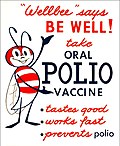Polio vaccine
Polio vaccines are vaccines that prevent poliomyelitis (or polio). Two types of polio vaccines are used throughout the world.
The first type was developed by Jonas Salk and first tested in 1952. Announced to the world by Salk on April 12, 1955, it is an injection of inactivated (dead) poliovirus. The second type was an oral vaccine developed by Albert Sabin, using attenuated poliovirus. An attenuated virus is a much less harmful strain of the same virus. Human trials of Sabin's vaccine began in 1957 and it was licensed in 1962.[1]
There is no long term carrier for poliovirus (carriers are people who carry the virus but have no symptoms of the disease), and polioviruses have no non-primate reservoir in nature. The virus cannot survive in the open environment for a long time. Therefore, interruption of person to person transmission of the virus by vaccination is the key step in removing polio entirely.[2] The two vaccines have eliminated polio from most countries in the world.[3][4] Polio worldwide has dropped from about 350,000 cases in 1988 to 1,652 cases in 2007.[5][6][7]
Polio Vaccine Media
This 1963 poster featured the United States Centers for Disease Control and Prevention's national symbol of public health, the "Wellbee", encouraging the public to receive an oral polio vaccine.
Doses of oral polio vaccine are added to sugar cubes for use in a 1967 vaccination campaign in Bonn, West Germany
Example of OPV in dragee candy
Administration of the polio inoculation, including by Salk himself, in 1957 at the University of Pittsburgh, where his team had developed the vaccine
Mass polio vaccination in Columbus, Georgia circa 1961 for the National Polio Immunization Program
Albert Sabin (right) with Robert Gallo, circa 1985
References
- ↑ "A Science Odyssey: People and Discoveries". PBS. 1998. Retrieved 2008-11-29.
- ↑ Fine P, Carneiro I (15 November 1999). "Transmissibility and persistence of oral polio vaccine viruses: implications for the global poliomyelitis eradication initiative". Am J Epidemiol. 150 (10): 1001–21. doi:10.1093/oxfordjournals.aje.a009924. PMID 10568615.
- ↑ Aylward RB (2006). "Eradicating polio: today's challenges and tomorrow's legacy". Annals of Tropical Medicine and Parasitology. 100 (5–6): 401–13. doi:10.1179/136485906X97354. PMID 16899145. S2CID 25327986. Retrieved 2009-01-02.
- ↑ Schonberger L, Kaplan J, Kim-Farley R, Moore M, Eddins D, Hatch M (1984). "Control of paralytic poliomyelitis in the United States". Rev. Infect. Dis. 6 (Suppl 2): S424–6. doi:10.1093/clinids/6.supplement_2.s424. PMID 6740085.
{{cite journal}}: CS1 maint: multiple names: authors list (link) - ↑ Centers for Disease Control and Prevention (CDC) (October 2006). "Update on vaccine-derived polioviruses". MMWR Morb. Mortal. Wkly. Rep. 55 (40): 1093–7. PMID 17035927.
- ↑ Kew O, Sutter R, de Gourville E, Dowdle W, Pallansch M (2005). "Vaccine-derived polioviruses and the endgame strategy for global polio eradication". Annu Rev Microbiol. 59: 587–635. doi:10.1146/annurev.micro.58.030603.123625. PMID 16153180.
{{cite journal}}: CS1 maint: multiple names: authors list (link)[dead link] - ↑ "Wild Poliovirus Weekly Update". Global Polio Eradication Initiative. 2008-11-25. Archived from the original on 2008-06-16. Retrieved 2008-11-29.










